#Not only descendants of enslaved Africans but all Blacks
Photo


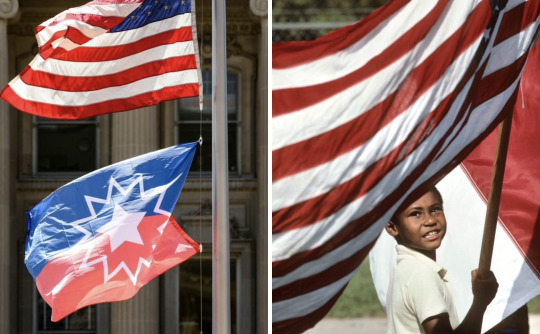


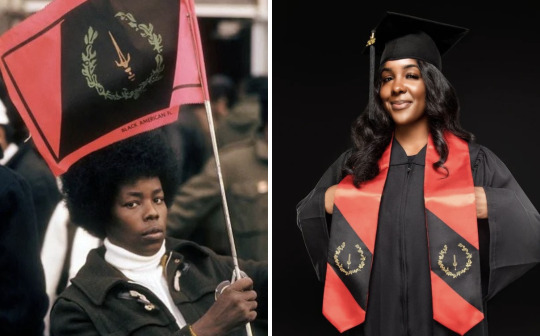
Juneteenth is a Black American holiday.
We call Juneteenth many things: Black Independence Day, Freedom Day, Emancipation Day, Jubilee Day. We celebrate and honor our ancestors.
December 31 is recognized as Watch Night or Freedom’s Eve in Black American churches because it marks the day our enslaved ancestors were awaiting news of their freedom going into 1863. On January 1, 1863, President Lincoln issued the Emancipation Proclamation. But all of the ancestors wouldn’t be freed until June 19, 1865 for those in Galveston, Texas and even January 23, 1866 for those in New Jersey (the last slave state). (It’s also worth noting that our people under the Choctaw and Chickasaw Nations wouldn’t be freed until April 28, 1866 and June 14, 1866 for those under the Cherokee Nation by way of the Treaties.)
Since 1866, Black Americans in Texas have been commemorating the emancipation of our people by way of reading the Emancipation Proclamation and coming together to have parades, free festivities, and later on pageants. Thereafter, it spread to select states as an annual day of commemoration of our people in our homeland.
Here’s a short silent video filmed during the 1925 Juneteenth celebration in Beaumont, Texas:
youtube
(It’s also worth noting that the Mascogos tribe in Coahuila, Mexico celebrate Juneteenth over there as well. Quick history lesson: A total of 305,326 Africans were shipped to the US to be enslaved alongside of American Indians who were already or would become enslaved as prisoners of war, as well as those who stayed behind refusing to leave and walk the Trail of Tears to Oklahoma. In the United States, you were either enslaved under the English territories, the Dutch, the French, the Spanish, or under the Nations of what would called the Five “Civilized” Native American Tribes: Cherokee, Creek (Muscogee), Chickasaw, Choctaw, and Seminoles. Mascogos descend from the Seminoles who escaped slavery during the Seminole Wars, or the Gullah Wars that lasted for more than 100 years if you will, and then settled at El Nacimiento in 1852.)
We largely wave our red, white and blue flags on Juneteenth. These are the only colors that represent Juneteenth. But sometimes you may see others wave our Black American Heritage flag (red, black, and gold).
Juneteenth is a day of respect. It has nothing to do with Africa, diversity, inclusion, immigration, your Pan-African flag, your cashapps, nor your commerce businesses. It is not a day of “what about” isms. It is not a day to tap into your inner colonizer and attempt to wipe out our existence. That is ethnocide and anti-Black American. If you can’t attend a Black American (centered) event that’s filled with education on the day, our music, our food and other centered activities because it’s not centered around yours…that is a you problem. Respect our day for what and whom it stands for in our homeland.
Juneteenth flag creator: “Boston Ben” Haith
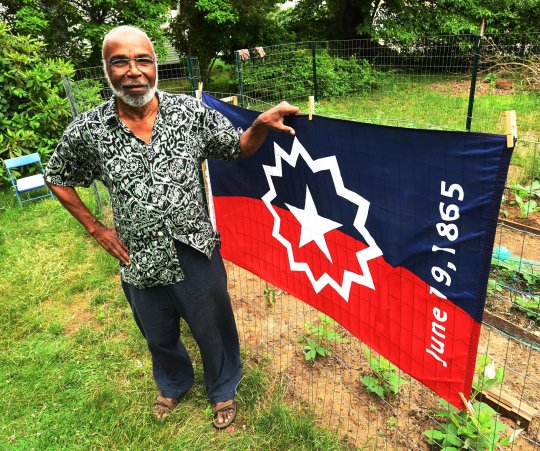
It was created in 1997. The red, white and blue colors represent the American flag. The five-point star represents the Lone State (Texas). The white burst around the star represents a nova, the beginning of a new star. The new beginning for Black Americans.
Black American Heritage Flag creators: Melvin Charles & Gleason T. Jackson

It was created in 1967, our Civil Rights era. The color black represents the ethnic pride for who we are. Red represents the blood shed for freedom, equality, justice and human dignity. Gold fig wreath represents intellect, prosperity, and peace. The sword represents the strength and authority exhibited by a Black culture that made many contributions to the world in mathematics, art, medicine, and physical science, heralding the contributions that Black Americans would make in these and other fields.

SN: While we’re talking about flags, I should note that Grace Wisher, a 13-year-old free Black girl from Baltimore helped stitched the Star Spangled flag, which would inspire the national anthem during her six years of service to Mary Pickersgill. I ain’t even gon hold you. I never looked too far into it, but she prob sewed that whole American flag her damn self. They love lying about history here until you start unearthing them old documents.
In conclusion, Juneteenth is a Black American holiday. Respect us and our ancestors.
#juneteenth#juneteenth flag#black american history#black american culture#ben haith#black american heritage flag#melvin charles#gleason t jackson#grace wisher#american flag#mascogos#juneteenth 2023
1K notes
·
View notes
Text
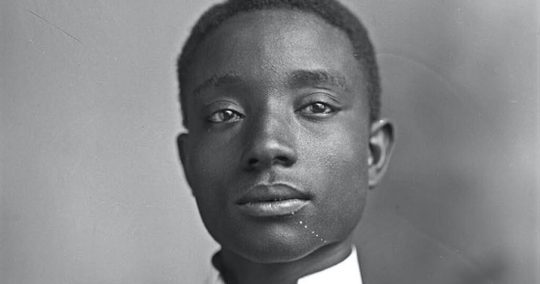
Freedmen Seek Their Fair Share of Billions of Dollars in Federal Aid and Why We Should Care/Rise UP and Support Them
By Eli Grayson
Eagle Guest Writer
Eli Grayson is a Creek Citizen and unabashed supporter of the Freedmen descendants of the 5 Civilized Tribes and the 1866 Reconstruction Treaties.
This past week, we celebrated our Nation’s 244th year of Independence with family and friends over BBQ and fireworks, we should all stop to reflect on its significance, particularly in light of the Black Lives Matter (BLM) movement.
The protests that have swept the country by those outraged over the death of George Floyd, Breonna Taylor, Ahmaud Arbery, and far too many others, most of whose names have not garnered national attention, has sparked a long-overdue National dialogue about the treatment of Black Americans in the United States, a reckoning with this country’s past, the many vestiges of slavery that continue today, and what we as a country can and must do to address racism. [It also reminds ALL of us that we have a long way to go.]
Not only have the egregious deaths of George Floyd, Breonna Taylor, and Ahmaud Arbery led to a growing chorus of voices calling for criminal justice reform, it has prompted many to reflect upon racism in both its subtle and overt forms today. It has prompted many to learn about events long celebrated by Black Americans such as Juneteenth (even the NFL recently recognized Juneteenth as an official holiday). And it has prompted many to consider what steps we as individuals, and as a society, can take to affirmatively address it. Here in Oklahoma, attention has focused on Black Wall Street and the 1921 Tulsa Race Massacre.
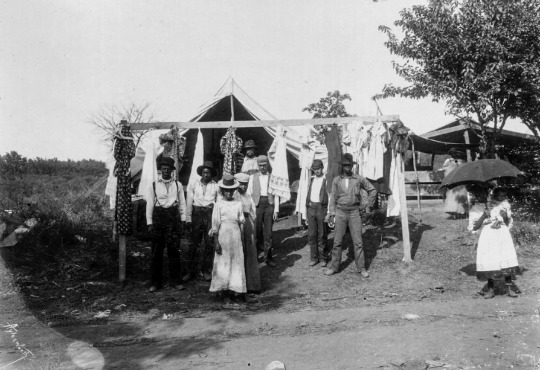
Well known is the U.S. Government’s abhorrent treatment of Native Americans, which included abrogation of countless treaties, appropriation of land, and forced removal to Western territories, including what is today Oklahoma.
Less well known, however, is the fact that the Cherokee, Chickasaw, Choctaw, Muscogee (Creek) and Seminole Nations – collectively known today as the Five Civilized Tribes – enslaved Africans. Like Southern plantation owners, they bought and sold slaves and treated them as chattel property. Indeed, slaveholding was such an integral part of the daily life of these tribal nations that each entered treaties with the Confederate States of America in 1861 to ensure its continuance.
Many Americans recently learned for the first time about the meaning and significance of Juneteenth, when nearly all remaining slaves in the United States and its territories were freed – a full 71 days after Confederate General Robert E. Lee surrendered at Appomattox on April 9, 1865 to Union forces led by General Ulysses S. Grant.
Enslaved Africans of Indian Territory
This was not the case for the enslaved Africans of Indian Territory. Even after Lee’s surrender, and even after General Granger read his Orders, the enslaved Africans of Indian Territory were kept in bondage.
Sadly, it was not until the Five Tribes of Indian Territory entered Treaties with the U.S. Government on March 21, with the Seminole Nation, on April 28, with the Chickasaw and Choctaw Nations, on June 14, with the Muscogee (Creek) Nation and on July 19, with the Cherokee Nation in 1866 – more than a year after Lee’s surrender – were these slaves granted freedom, tribal citizenship, and equal interest in the soil and national funds.
Each of these treaties (collectively known as the Treaties of 1866) contained provisions freeing the slaves and an express acknowledgement that the U.S. Constitution was, and shall remain, the Supreme Law of the land. Notably, there was no mention of tribal law or sovereignty insulating these slave holding tribes from full compliance with the U.S. Constitution, which includes all the Civil War reconstruction amendments.
Today, we find ourselves at a turning point in society. Similar to the country as a whole, the Cherokee, Chickasaw, Choctaw, Muscogee (Creek), and Seminole Nations must take this seminal moment to carefully examine their slaveholding past, their prior allegiance with the Confederacy, enshrined through Treaties entered in 1861, and how they can make amends by fully adhering to both the letter and spirit of the 1866 Reconstruction Peace Treaties.
Congressional legislation
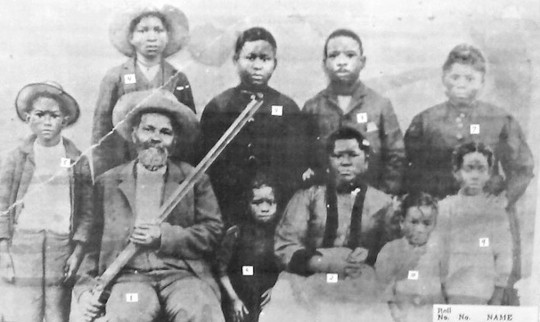
The three House bills are H.R. 2, the Invest in America Act, which includes $1 billion for the Native American Housing Block Grant Program to create or rehabilitate over 8,000 affordable homes for Native Americans on tribal lands; H.R. 6800, the HEROES Act, which includes $6 billion for housing and community development to respond to the Coronavirus; and H.R. 5319, the Native American Housing and Self-Determination Reauthorization Act (NAHASDA), which would authorize $680 million in grants to tribes in the first year and grow to $824 million in the fifth and final year.
Why is this important and why should you care? NAHASDA was originally passed by Congress in 1996 to address poor housing conditions in Indian country and last re-authorized in 2008. It is a flagship Federal law for Native American tribes and the vehicle through which approximately $650 million flows annually to the tribes. In Oklahoma, the Five Civilized Tribes receive more than $62 million annually in direct grants for housing and community development projects. These grants are based on a formula that takes into account various factors including the number of tribal members. Notably, these grants are supported by taxpayers.
For the 2021 Fiscal Year, the U.S. Department of Housing and Urban Development (HUD), which is responsible for administering NAHASDA, has informed the Five Civilized Tribes that they can expect to receive $62,223,462. Thus, nearly 10 percent of all NAHASDA grant funds will go to just these five tribes. By any measure, this is a significant sum, particularly when you consider that there are approximately 573 federally recognized tribes in the United States today, according to data from the federal Bureau of Indian Affairs. And, the final amount will be even greater as Congress has (appropriately) increased the amount of funds for NAHASDA far above the amounts requested by this Administration, including an appropriation of $825 million for this Fiscal Year.
Oklahoma Tribes receive millions in housing aid
Native American Tribes also receive other competitively awarded grants from HUD through a program known as the Indian Community Development Block Grant program. The Choctaw Nation was recently awarded $900,000 to rehabilitate 60 single-family homes while the Cherokee Nation received the same sum to construct a community building, which will house the Early Head Start program. The Chickasaw Nation was awarded $900,000 to construct a youth center in Ardmore, Oklahoma that will provide a safe and clean place for activities and services for Chickasaw tribal youth while the Muscogee (Creek) Nation will use its $900,000 award to construct a facility on the campus of the College of Muscogee Nation. The facility will include space for exhibitions and a lecture hall. These are worthy projects and it is vital that all those in need, including Freedmen descendants, can benefit.
Why Freedmen are concerned
Now if you have read this far, you must be thinking this is great news for these five tribes. And indeed, it is. However, for the Freedmen who are de facto members of the tribe, they may never see a dime of these funds if history is any guide.
Steps such as conditioning or denying the issuance of Citizenship Cards to Freedmen descendants, as well the disenrollment of Freedmen as tribal citizens, is what first led Congress in 2008 to include language in the NAHASDA re-authorization bill to link the receipt of NAHASDA housing grants to compliance with the treaty rights and benefits conferred on the Freedmen through the 1866 treaties.
That is why the efforts of House Financial Services Committee Chairwoman Maxine Waters, D-California, to fight on behalf of the Freedmen of all Five Civilized Tribes is so vital.
The committee she chairs oversees HUD and is responsible for periodically re-authorizing NAHASDA. A bi-partisan bill introduced in Congress last December would re-authorize NAHASDA. However, unlike the 2008 legislation, which contained language to prevent the Cherokee Nation from denying Cherokee Freedmen under the Act, the bill introduced by Rep. Denny Heck and co-sponsored by Reps. Scott Tipton (R-Colorado), Ben Ray Lujan (D-New Mexico), Tom Cole (R-Oklahoma), Deb Haaland (D- New Mexico), Don Young (R-Arkansas), Rep. Gwen Moore (D-Wisconsin), and Rep. Tulsi Gabbard (D-Hawaii), does not contain any protections for the Cherokee Freedmen nor the Freedmen of the other Civilized Tribes. Similarly, the version introduced in the Senate last week is devoid of such protections for the Freedmen.
Disturbed by the pattern of denying benefits to Freedmen, Chairwoman Waters is seeking assurance that descendants of Freedmen are not denied NAHASDA funds received by the Tribes. The Descendants of the Freedmen of the Five Civilized Tribes have been working to include language that would ensure that the Freedmen of all Five Civilized Tribes receive taxpayer funded NAHASDA benefits. A similar effort advanced by former House Financial Services Committee Chairman Barney Frank was successful and helped to ensure that Cherokee Freedmen received NAHASDA benefits. And in case, any question whether such protections were needed, one look only to the fact that HUD held up NAHASDA funds to the Cherokee Nation for noncompliance.
Native Americans keep fight against Freedmen
Given the harsh treatment of Native Americans at the hands of whites, one naturally would expect these Five Tribes and their supporters and defenders to be more sensitive to the plight of Freedmen who today make up more than 200,000 descendants.
The reality has been quite the opposite.
Despite knowing all this, tribal leaders and their supporters and defenders continue to maintain that such language is not needed and further argue that such language infringes upon the sovereign rights of ALL Native American tribes.
Both arguments could not be further from the truth.
Language ensuring that the Freedmen have access to federal housing benefits is urgently needed for the very reason that Freedmen have routinely been denied NAHASDA benefits for years. And let’s be clear – language we are seeking does not apply to ALL tribes, but rather only to the Freedmen of the Five Civilized Tribes.
And it does not stop at NAHASDA benefits. Freedmen have been denied tribal citizenship, benefits, and the right to vote as well. Regarding sovereignty, these are federal taxpayer dollars – as such, the federal government and, by extension, its American citizens, have a vested interest in ensuring that all tribal members, including Freedmen, benefit from the funds appropriated pursuant to NAHASDA.
If tribes feel so strongly about their sovereign right to continue to discriminate against Freedmen through denial of federally funded benefits, they can opt to refuse the funding, which would then be redistributed to other tribes. Indeed, it is the height of hypocrisy for any of the Five Civilized Tribes or their supporters to makes these arguments as they count the Freedmen when it comes to the allocation of federal housing grants from HUD yet turn around and deny those very same Freedmen from receiving such benefits.
Freedmen are equal, lawful Tribal citizens
And don’t be mistaken. While Freedmen should be treated as equal citizens under the respective 1866 Treaties, the language we are seeking to include in each of these three bills carefully avoids this ensuring Freedmen receive taxpayer housing and community development benefits on the same terms and conditions as their Native American sisters and brothers.
Indeed, in many instances, these truly are their sisters and brothers given the extensive intermixing of Freedmen and By Blood tribal members over the years. Ironically, this has resulted in some members of a family being considered by the Five Tribes as Indian and therefore citizens of the Tribe while other family members being considered by the tribe as non-Indian and therefore like black sheep.
Yet every time we make a further legislative concession and are led to believe that we are close to a final agreement on language, the Tribes and their supporters and defenders move the goalposts. Sound familiar? Yes, a sensitive issue. The Freedmen only seek to ensure that the Five Civilized Tribes comply with the Treaties of 1866.
Tribal Nations’ actions throw shade on BLM
Lastly, the Five Civilized tribes cannot have it both ways. They cannot on the one hand claim they are victims of discrimination and participate in BLM rallies yet discriminate against Freedmen by denying them suffrage and other rights of tribal citizenship under the guise of sovereignty.
And we are under no illusion that fighting this battle for justice and equality will not remain a challenge. The Five Civilized Tribes have wielded their extensive influence amongst the Nation’s 573 tribes to frame the debate and shape the position of the National tribal organizations in Washington, whom the Members of Congress look to when writing laws that affect the tribes. Adding to the challenge is the fact that the Five Civilized tribes have deployed their sizable resources to contribute to key Members of Congress with the dual purpose of keeping Americans in the dark about their slaveholding past and ensuring that these legal protections for Freedmen never see the light of day in Congress.
But just like our Nation, it is time for the Five Civilized Tribes to stand up and confront their past by taking immediate and affirmative steps to ensure that all descendants of Freedmen receive the federal housing benefits.
This they can do by supporting legislation being courageously advanced by Chairwoman Waters that would require the Five Civilized Tribes to both comply with their Treaty obligations of ensuring access to benefits for Freedmen and report on their compliance to Congress.
Featured Image (Top), Buck C. Franklin, Nashville, Tennessee, 1899, Calvert Brothers Studio Glass Plate Negatives Collection, The Tennessee State Library and Archives Blog
#Black Lives Matter for Freedmen Descendants of the Five Civilized Tribes#Black American Freedmen#Freedmen#indians#slavery
105 notes
·
View notes
Text
6 Black Gods of Ancient America You Should Know
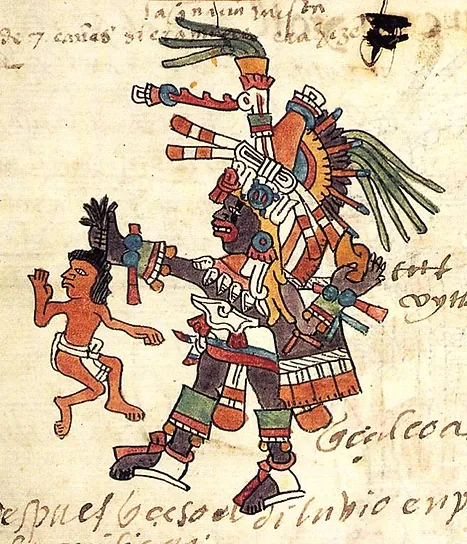
"Several Indian nations, such as the Mayans, Aztecs, and Incas, worshipped black gods along with their other deities, and the Mayan religion particularly exemplifies the high esteem in which the negroes were held." --Harold G. Lawrence, The crisis, 1962
Why were all indigenous religions and spiritual systems deemed as "pagan" or "evil"and were replaced during colonizations? It would be hard to subjugate a people who were previously worshipped without replacing old traditions with new ones. Lets examine some of the anicent gods found right here in America before colonization. "Many Scholars have noted, the Black gods of the Americas are typically gods of
medicine and healing, trade, or music and dance. According to these scholars, these associations are based on the traditions introduced by actual Black people."
1. EKCHUAH, THE BLACK STAR

EKCHUAH, was the sixth most commonly depicted deity in the Mayan codices, protrayed at least forty times. He is painted Black with thick lips, His name means "Black Star" (ek means "star" and chuah means "black" in Yucatan Maya). Flod Hayes III reports that among many of the Indians of Guatemala, "the black Christ is referred to in private as Ekchuah," who Harold Lawerence describes as "black and woolly-haired" and "unmistakenly Negro." In Africa and the Discovery of America, Leo Weiner connects the Mayan god Ekchuah to the African Nama societies of the Malinke and Bambara people of West Africa. Ekchuah may have been based on an older Black god, known to us only as God M.
2. GOD M

God M is represented throughtout the ancient codices as a Black god, specifically an "old man" with a toothless jaw or one tooth. He appears to be a trader, often shown carrying goods on his head. In volume III of Africa and the Discovery of America Leo Weiner says West Africans like Malinkes and Bambaras made voyages to the Americas long before Columbus. He identifies many of the Mayan and Aztec gods as being derived from the reverance paid to these Black visitors.
3. THE MAYAN PRIESTS

Frederick Peterson, In his 1959 work Ancient Mexico, remarked: " We can trace the slow progress of man in Mexico without noting any definite Old World influence during this period (1000-650BC), except possibly a strong Negroid substratum connected with the Magicians. "
The Magician may have been West Africans who traveled to Mexico or a class of Black people who could ONLY marry among themselves, effectively presereving the African phenotype over untold generations. This reverence for Black people may have something to do with why many Native Americans, inculding the Mayas, respected enslaved Africans and revered Black gods that represented the principles of healing and good fortune.
4. TEZCATLIPOCA, THE AZTEC GOD
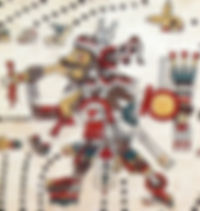
Tezcatlipoca was one of the most important gods in ancient Mesoamerica. He began as important diety for the Toltecs and later became the supreme god of the Aztecs. He was seen as a Creator, the god of sustenance, a patron god of warriors, and the bringer of both good and evil. "Black Tezcatlipoca" is the most feared and highly revered. The earliest representations of him represent him as black. His priest would cover themelves in black soot or charcoal to associate themselves with the Black god. They would also paint the newly appointed king black to associate him with Tezcatlipoca.
5. KOKOPELLI, THE GREAT HUNTER

Kokopelli is a well-known fertility god and hunter among the Hopi and Zuni people of the America southwest. As the spirit of fertility, he is seen as responsible for introducing corn (agriculture) to various peoples across the Americas. Kokopelli was first found in Anasazi rock cravings, but he also appears in Missippian artifacts. Throughout South America, he is known as Ekoko. He is believed to descend from the Mayan Ekchuah. Kokopelli is identified with the southwestern Tewa people's god Nepokwa'i, a great hunter who is described as "a big black man."
6. BLACK GOD OF THE NAVAHO

Among the Navaho, there is a deity known as Black God. He is not widely-celebrated, but is very important because his knowledge of medicine saved the rest of the Navaho gods from certain death. Black God is the Navajo god of fire. Perhaps because of this, he is also considered the creator of the stars. He is often depicted as black "like space" and wearing a crescent moon on his forehead, with the stars of Pleiades dotted on his temple. But Black God was most likely a medicine man before he came to be known as the god of fire.
Article Source::
Black God: An Introduction To The World's Religions And Their Black Gods by Dr. Supreme Understanding
15 notes
·
View notes
Photo

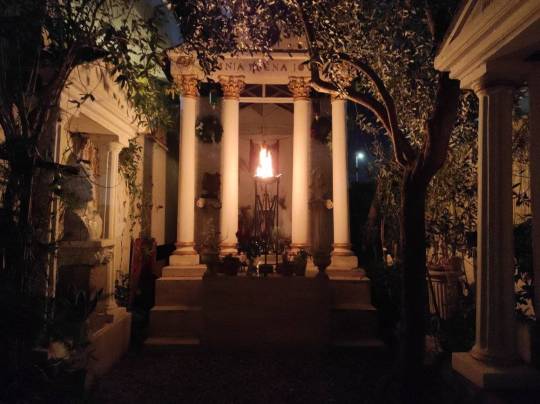
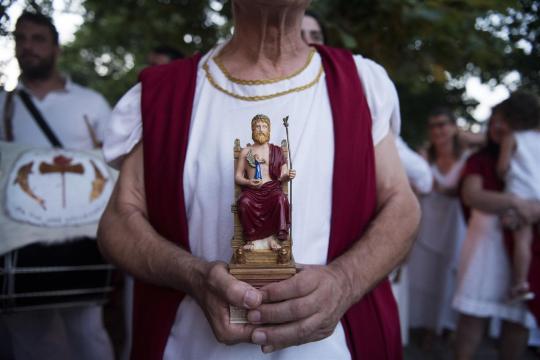
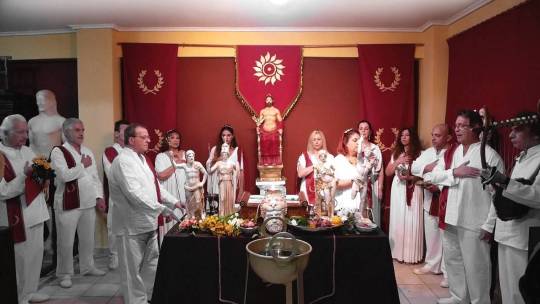



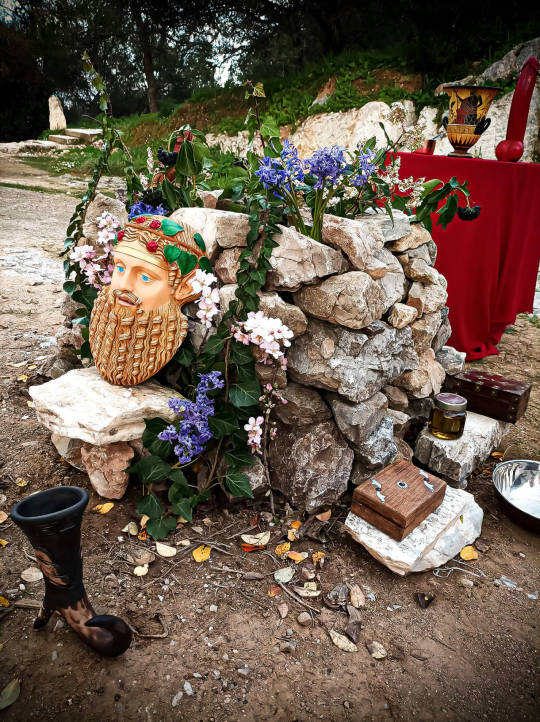


On November 8, 392 C.E., the unfortunate Theodosius I officially banned all worship of domestic deities with fire, incense and libations, this was just part of the Christian persecution against gentile religions that lasts to the present day.
More than 1500 years have passed, and it is good to see that traditional religions are resurrecting, or even strengthening, whether among African descendants in the diaspora, Europeans, descendants of ancient Native American peoples, Zooroastrians in the Middle East and the like, EVERYONE has the right to worship (or not) the Divine according to the tradition one chooses!
What seems so obvious to some today in some countries has been achieved with great suffering, and is still a difficult reality in many places.
Christianity has always placed a lot of emphasis on those who were killed and persecuted, art is full of examples of martyrs in their agonies, but the number of those killed and persecuted by them is much higher, just think of the Inquisitions and other persecutions of traditional religions. around the world, only in Mexico and Peru the amount of the dead population exceeded 50%, not counting enslaved blacks who were forced to adopt the faith of their slave masters.
So may paganism bear fruit in peace and may ALL religions respect each other, which is much better than just tolerating each other.
Pictured are various groups in Greece and Italy, who worship the ancient gods in the present day, despite Theodosius' ban.
80 notes
·
View notes
Text
Blood like Magic and why I’ll be considering myself a hater

@tea-and-a-clandestine-agenda
I’m going to start off by saying I’m 90% into the book, meaning I haven’t finished it yet but I know enough about it to criticise the fuck out of it. This is going to contain spoilers lol.
Firstly, that book cover is absolutely gorgeous. This book does have one (1) good thing and it is the very talented illustrator who created the cover —whoever they are, I applaud them because they made Voya look cool and not irritating and dumb.
The premise of the book is interesting. We’re in a near-future Toronto where witch communities exist. Now, these witches are unique in how their characteristic bit of magic is granted to them by their ancestors after they have their first Bleeding (aka period for whoever has a uterus and very gross eye-and-ear bleeding for whoever doesn’t). The process through which a witch acquires their unique magic goes as follows: after the Bleeding, one of their ancestors Call them, set a trial for them and if they pass, good for them! They have their magic now! If they don’t pass, they don’t get magic and are thus seen as pariahs by their fellow witches. Now, enter Voya Thomas. She’s part of Toronto’s Black witch community and has both African and Trinidadian ancestry —also, she likes to cook, a lot, food is her life and the very air she breathes. Voya has had her Bleeding and is Called by ‘Mama Jova’ —an ancestor who lived as a slave in Antebellum America and died being whipped to death by her enslavers after the love of her life was murdered. Mama Jova tells Voya she needs to ‘destroy her first love’; otherwise, her whole family will lose their magic and her little sister, whose life is tethered to that magic, will die. Therefore, Voya starts a journey trying to find her first love in Luc (a guy she meets in a conference at this mega-important company).
My first problem with the book is the very basis on which the plot stands. Never will I believe that a woman who saw her lover being murdered (and also who sacrificed herself in order to help other enslaved people escape their enslavers) entreated her descendant to ruin someone they hold close to their hearts. How? Just how? It’s stupid, it doesn’t make sense. She died saving other people and now she wants her descendant to suffer much like she did and she wants her descendant to orchestrate that? And she’s going as far as to promising to kill a child and ruin what she died to protect in order to get her way? I call bullshit. Utter, fucking bullshit. Mama Jova’s a joke, I tell you.
I tried to look pass that because this is the author’s debut novel and it has a high rating on Goodreads, though. I thought Mama Jova didn’t really mean what she asked Voya to do… but she did, and Voya handled it all in such a fucking stupid way. I can’t with her.
Okay, so in the process of trying to determine how she’s going to approach her task Voya:
Falls in love with Luc
Finds out that Luc’s ‘sponsor dad’ (aka the CEO of the mega-important company Luc works in, who is called, in-text, a neo-coloniser because he brought Luc to Canada from Mexico in order to brainwash him about the importance of his company) was responsible for the death of her forgotten aunt and the near-downfall of her whole community
Realises that Mama Jova wasn’t only referring to her first romantic love, but to her first platonic love, too, meaning that now Voya needs to choose whether to destroy Luc or her cousin Keis (aka her best friend)
Realises that Mama Jova’s ‘destroy’ doesn’t necessarily mean ‘kil’: it can also mean ‘ruin their life’ which is so much better, right? Agh, Mama Jova is so charitable!
All throughout the book, Keis is Voya’s biggest support. She’s someone who wants to look beyond her witch identity and wants to get an education! She wants to work! Be independent! Be free from her family’s limitations! Towards the end of the book, Keis achieves just what she wants in the form of an internship in the mega-important company.
Now, if Voya were to choose to ruin Luc’s life, that would mean he wouldn’t be able to inherit his sponsor dad’s mega-important company (and spoiler: the sponsor dad is the bad guy of the story); if Voya were to choose to ruin Keis’s life, that would mean she would be trapped in her house forever, unable to forge herself a future, not even allowed to step foot out of her house. Luc is well-off, and having spent virtually all his formative years in the mega-important company, he can easily get a position elsewhere. Keis comes from a working-class family and having her life ruined = depending on her family for the rest of her life + not being allowed to leave her house.
So, Voya, as the paragon of common sense, chooses to *insert Semana Santa drums rolling* RUIN KEIS’S LIFE. I CAN’T STRESS THIS ENOUGH, SHE DAMNED HER BEST FRIEND AND COUSIN TO LIVING IN A PRISON ALL HER LIFE.
Her argument? ‘She’ll survive uwu’
Luc, obviously, won’t survive a life without his privileges.
Be fucking for real.
I hate this so much. So fucking much. And do you know what happens just after she ruins her cousins life? Luc’s sponsor dad kidnaps her whole family! Because you know he’s the villain! Voya could’ve killed him and she chose to imprison her cousin!
The last 10% of the book will tackle that, I suppose. Depending on how bad it’s handled I will choose whether to read the next book or not.
Now, ✨a list of the things I’m petty about✨
The family dynamic -> Voya’s family is comprised of: her cousin Keis, Kei’s twin sister Keisha (fun fact! Keis’s full name is also Keisha), her other cousin Alex, her mother, her father, her father’s current wife (this is a huge side-eye ngl), her half-sister (aka the one who could’ve died), Keis’s mother and father (who are divorced) and her grandmother (the matriarch of the family). The family has a lot of members, is somewhat messy, and I couldn’t connect with any of the characters. Also, you wouldn’t caught me dead living under the same roof with my divorced husband; I’m sorry but wtf
The technology -> just no. In this near-future Canada people can rate each other, find each other’s location with a click and more things out of that one Black Mirror episode, and no one bats an eyelash at this. If this is were the future I’m supposed to be an adult in, I promise I would commit a very rash decision and fling myself out my window, sorry not sorry. Morally, I’m against every technological advancement that this books stands for and it’s making me sick that the hyper-digitalisation is never discussed in anything but a bad light
People go around with a pronoun tags and they introduce themselves with a ‘hello my name is xyz and my pronouns are something/other’ and yet you have to show whether you have XX or XY chromosomes in your ID card? I’m sorry but we don’t showcase someone’s genetic makeup today, why would a more progressive society do it? What I’m going to say is going to sound horrible, but it just feels like a way to thrust in unnecessary transphobia for sake’s sake (I should add that the author’s cis)
Food -> Voya loves food, so much so that she makes her internal dialogue all about food. She could be describing a scene where Mama Jova or another person are being whipped to almost death and she would be comparing their blood to a crème brûlée or something. In fact, there are whipping scenes in the book and I believe she does compare them to food. It’s exhausting. She makes her whole personality about food and it’s exhausting
So-called impure witches -> the witch community is divided into impure witches (who kill and torture in order to gain heightened magic) and pure witches (who don’t) and I hate the very existence of impure witches. Apparently they pick their victims at random and that’s supposed to be fine by us? Voya’s family is one of pure witches, but still it makes me queasy how her internal dialogue somewhat implies that impure witches are uwu not that bad
There’s a line about a gay witch having used in-vitro fertilisation and surrogacy to have like six children. It made me uncomfortable because I’m very hesitant about surrogacy + apparently his children don’t want to know about their mothers, which seems like a very out-of-touch conception of surrogacy and other types of unconventional ways of starting a family. Idk, I’m on adoptee TikTok and it’s made me think about these things
I don’t like any of the characters aside from Keis and maybe Luc
19 notes
·
View notes
Text
Palestine-Israel Just my thoughts
On this page, I primarily talk about anime. Sometimes, I do this in incendiary and political ways.
I do not imagine my thought about this specific issue will go very far on Tumblr, but this is one of my only platforms, so here I go:
I will not pretend to understand the intricacies of what is happening between Israel and Palestine right now. It is exceedingly confusing and these two "nations" have had issues with each other for nearly a century, but why wouldn't they?
At it's core you have two primary groups of people. You have the Palestinians who have lived there and existed there in Gaza for sometime now. They've existed their for many decades and even centuries before the state of Israel tried to lay claim to Gaza, and then you have the Zionist Jews and Israelis who feel that they have the right to be there and have felt that way for the last 100 years.
However, the problem comes in that the state of Israel and the Zionist that support them, feel that they have the sole right to occupy Gaza.
Their radical political beliefs and assumptions ignore the existence of Palestinian Christians, Jews and atheists as well as the existence of Israeli Muslims and Christians.
Why, because it's not about religion. It's about power, control, wealth and xenophobic tribalism. What the state of Israel is doing to the nation of Palestine is nothing more than modern day colonization.
That's so crazy to think about, because 'colonization' is such a sterile term that has in many ways lost its power. It is muted and polite. It is a civil word, because we see it written flagrantly into our black and white history books, and we normalize it because it is the story of the birth of this very nation (the United States).
However, this is the truth of colonization. Palestine is the truth of colonization and the avatar of its victims. Judaism is Israel's weapon. It is their sword and their shield in the same way that Christianity was England's weapon in the same way it was England's sword and shield.
The Christian settlers came to "America" under the thin veil of religious prosecution and the desire for religious freedom (and I'm sure they were prosecuted) but what they did in return was slaughter 55 million Native Americans. They wiped out 90% of the indigenous populations in the Americas (90 fucking percent). It is believed that they killed 60 million black/African enslaved individuals.
The numbers are so mind boggling that the are incomprehensible. They are impossible for the mind to fathom. I know, because I'm a mathematician, and I can't even make sense of these numbers. I can't even begin to conceptualize the chaos, the destruction, the brutality, the calamity, the senselessness and despair. I cannot begin to comprehend this level of human depravity in the thinly veiled name of religion.
It breaks my heart, which is why all of my ancestors and myself weep for Palestine, because they know that pain. I feel the cries of the Palenstinian people in the blood that runs through my veins, because it was the blood of my ancestors that was spilled.
I used to believe that my ancestors survived long enough to have the decedents who had descendants who had descendants that would eventually have me, but I was wrong. They did not survive. The average life span of a black/African enslaved individual in the Americans was 21 to 22 years old. I'm 27. I have outlived many of my enslaved ancestors.
In the same way, the informed American Populus watches in horror on TikTok as the lives of 38,000 Palestinians (70% women and children) have been snuffed out and cut short by Israeli's genocidal military regime.
It is for that reason that I see no two-state solution. I am not antisemitic. I abhor antisemitism. I spit in its face wherever it may choose to rear it's disgusting head. I am a black woman. I am a raised born again Christian turned atheist, and my heart has never held contempt for the Jewish people. I empathize with the pain of marginalinzed communities, because all of my identities are marginalinized at every intersectionality that merges together to create me.
With this being said, what I also abhor is Islamophobia, and tribalism, and Xenophobia, and colonization and hatred for ones fellow man, woman, and child for the things that they cannot control and will never be able to control.
I call out Zionism for what it is. It is racism. It is white supremacy. It is the flying flag, bleeding heart of modern day colonization extended to new marginalized communities by the ones who were once oppressed.
Zionism and Judaism may be interrelated, but they are in no way the same. Anti-Zionist Jews do exist. Returning to Gaza may be a tenant of the religion, but this radical and violent Zionism is not. Remember that being bullied doesn't give anyone a hall pass to bully someone else.
I don't know what the solution is going forward. I have no expertise in this area. Everything that is happening in the Middle East is a cluster fuck created by nations of white men who sought out power and wealth, and did not care who they hurt in the process. The US and England carved up the Middle East, made these fictious nations and instigated these problems all so that they could have their precious oil to shove down our throats (the throats of the American people).
Well, fuck them and their oil, because I don't fucking want it. We don't fucking want it anymore. We want walkable cities, public transportation, and not to sit in our cars all fucking day long just to get to work and go to the grocery store.
So stop funding this genocide Joe Biden and congress! Stop lying to us and insulting the intelligence of the American people. We know what you did. Banning TitTok will not make us ignorant. You put the state of Israel in Gaza so that you could control the entire Middle East through Gaza.
You didn't create a country for Jews in Gaza, because you wanted them to have a Paradise where they could be safe. You all could have created safety from them here and in Europe, but no one wants to talk about how aligned America actually was with the Nazi regime back in 1940. If you wanted them to have a Paradise, you would have put them somewhere peaceful.
Instead, you inserted them somewhere for which no one in that area will ever know peace as long as the US is involved in the politics of Gaza.
To Biden, to congress do something right and consequential for the first time in your fucking lives. Stop being career politicians. Listen to the America public. So stop funding the Israeli military, demand the ceasefire. Abandon the two-state solution and work to rebuild Palestine. Those Palestinians deserve something that so many people of color have been entitled to but never received: reparations and peace.
Note to anyone who reads this:
If you know more about Palestine and educate me, feel free to drop a comment. I am very open to learning.
If your a Zionist, Israel, Netanyahu sympathizer, I don't want to hear it. You can cram it. Genocide is genocide is genocide. Colonization is colonization is colonization. Period.
#free palestine#palestine#free gaza#israel#tiktok#tiktok ban#joe biden#congress#netenyahu#rafah#save rafah#anti zionism
4 notes
·
View notes
Text
Margaret Sanger: A Racist, Ableist Eugenicist
In honor of the March for Life taking place yesterday, here’s a friendly reminder that Margaret Sanger was a racist, ableist eugenicist.
In her article My Way to Peace, she outlined this 3-step plan to prevent “fifteen or twenty millions of our population” from tainting society:
Sterilizing anyone with mental or physical disabilities and putting them to work on segregated farms for the rest of their lives.
Putting poor, illiterate, drug-addicted, or sex-working individuals to work on state-run concentration farms, which they would only be allowed to leave if they reformed and accepted sterilization.
Institute mandatory birth-control training for women with serious illnesses like heart disease, to discourage them from having children.
In that same document, she specifies that she includes those “barred from entrance by the Immigration Laws of 1924” and their descendants among the undesirable groups that should be sterilized and segregated—said immigration laws barred Asians and imposed severe restrictions on the number of Africans and Arabs allowed to enter the country.
Her support for this plan actually resulted in 30 states passing laws allowing for forced sterilization: “At least 70,000 people in the United States were forcibly sterilized under the laws promoted by Sanger and her associates. Far more, especially women prisoners and women on welfare, were surreptitiously sterilized.”
She went on to say in A Better Race Through Birth Control that “women of subnormal mentality, however lacking they may be in vision and altruism, would prefer to avoid the pain and responsibilities of procreation, if the satisfaction of sex could be divorced from reproduction.”
In her article In Defense of Assassination, she said, “Exterminating warfare is also waged against the savage members of the human race wherever they oppose the establishment of conditions necessary for the development of the more highly organized types.”
In fact, Sanger’s eugenicist beliefs are so blatant that a Planned Parenthood center in NYC actually removed their founder’s name from their clinic because they didn’t want to be associated with her eugenicist policies—an ironic decision, as they continue to advocate for some of the methods of eugenics Sanger supported.
While Sanger’s ultimate mission of segregation and forced sterilization has failed, her eugenicist beliefs continue to succeed in more subtle ways. For instance, in NYC in 2013, more Black babies were aborted than born, at a rate of 67.3 per 1,000, a rate vastly higher than any other racial group. While that rate decreased to 32.6 in 2020, the disparity between races increased, with Black babies being aborted over 5 times more often than their white counterparts.
The fact that Margaret Sanger supported the forced sterilization and enslavement of POC, drug addicts, sex workers, and disabled individuals has been suppressed for decades, so as not to complicate the message that she is a champion of women’s rights. Ignoring these facts—ignoring her own words—allows these evils to continue uncontested. We cannot remain in ignorance. We cannot meaningfully separate Planned Parenthood’s current actions from their founder, especially as the racial disparities are only growing more extreme. Regardless of how you feel about abortion, it’s eugenicist roots are a vital piece of information to have when considering it.
Now that Roe v. Wade has been overturned, the March for Life has turned even more attention to mitigating the damage done by Margaret Sanger’s eugenicist beliefs. Specifically, to ensure that all pregnant women and their families have easier access to several kinds of support, so they can make a truly informed decision instead of believing that abortion is their only option.
With every woman, with every child.
#march for life#prolife#pro life#catholic#catholicism#margaret sanger#abortion#eugenics#racisim#cw forced sterilization#abelism
4 notes
·
View notes
Text
Dr. William B. Allen chided critics who are too quick to malign the curriculum, saying, 'It’s only those who don’t take the time to read it who will misstate it'
An academic who helped craft Florida’s African American history curriculum called out Vice President Kamala Harris for mischaracterizing the course material in interview footage ABC News left on the cutting room floor.
The Florida Board of Education recently approved a new curriculum for African American history, with a section on how "slaves developed skills which, in some instances, could be applied for their personal benefit" drawing heavy criticism.
Harris condemned this line in a recent speech, declaring that "they decided middle school students will be taught that enslaved people benefited from slavery. They insult us in an attempt to gaslight us, and we will not stand for it."
The former chairman of the U.S. Commission on Civil Rights and Florida’s African American History Standards Workgroup member, Dr. William Allen, told ABC News Harris completely mischaracterized the curriculum with a "categorically false" assessment.
DESANTIS LETS LOOSE ON FLORIDA ‘OBSESSED’ KAMALA HARRIS SPEECH RIPPING STATE'S BLACK HISTORY STANDARD
However, the network didn't air those comments on Saturday's "ABC World News Tonight." Only a small segment from Allen's interview aired, when he defended the controversial line, "It is the case that Africans proved resourceful, resilient and adaptive, and were able to develop skills and aptitudes which served to their benefit both while enslaved and after enslavement."
Florida Gov. Ron DeSantis’ press secretary Jeremy Redfern shared several more minutes from Allen's interview with ABC News in a series of tweets, highlighting Allen's response to Harris.
"Yesterday, @abcnews aired a very small section of their interview with a member of Florida’s African American History Standards Workgroup, Dr. William B. Allen. Here’s more of the interview, where Dr. Allen debunks @VP’s narrative and calls her criticism 'categorically false,'" he said.
"The only criticism I’ve encountered so far is a single one that was articulated by the vice president and which was an error," Allen told ABC News according to the audio Redfern released. "As I stated in my response to the vice president, it was categorically false."
He then went on to claim the course is not portraying slavery as beneficial in itself, but rather how African Americans managed to prove themselves adaptable and resilient in a time of crisis.
"It was never said that slavery was beneficial to Africans," he noted. "What was said, and anyone who reads this will see this with clarity, it is the case that Africans proved resourceful, resilient and adaptive and were able to develop skills and aptitudes which served to their benefit, both while enslaved and after enslavement."
KAMALA HARRIS RIDICULED FOR ‘NONSENSE’ COMMENTS AT TRANSPORTATION ROUNDTABLE: ‘SHE CAN’T BE SERIOUS'
When the interviewer asked if the wording should be amended amid all the controversy and confusion, Allen cited his own ancestry and firmly said it should not be changed.
"I do not. No. I think it would be effectively to erase people’s history. Let me illustrate that for you, if I may," Allen said. "My great-grandfather is someone who came from the islands and who was enslaved here and whose own resourcefulness, resilience, and adaptiveness was certainly instrumental in producing for his family, his descendants, the ability to prosper here in this country."
He then emphasized his point by calling back the wording of the curriculum, "Hence, from his resourcefulness, we derive benefits. I think anyone who would try to change that language would be denying that great-grandfather Cidipus made any contribution. I certainly could not endorse doing that."
He later restated his assertion that the course material focuses on resilience and adaptability in the face of oppression, rather than submission to it.
"We’re talking about the experience of oppression and how people respond to the experience of oppression, and we want people to recognize that there’s an opposite to Stockholm Syndrome. People don’t necessarily simply embrace their oppressors when they’re oppressed. They also react adaptively and they find ways to make pathways for themselves even in the presence of oppression," he said. "That’s what calls upon their resourcefulness, their resilience and their adaptability."
As the interview came to a close, he took another swipe at Harris for making such claims while purportedly not having read the actual course materials.
"I just want to foster and encourage everyone to take the time to read, or as I said in my response to the vice president, I think every intellect can understand the language written there if people only take the time to read it," he said. "It’s only those who don’t take the time to read it who will misstate it."
8 notes
·
View notes
Text
Let's talk about San Baltasar, the Wise King, Saint of Afroargentines.
I think it's extremely interesting how one of the biggest afrodiasporic cults native to Argentina is that of El Santo Negro (the Black Saint) St. Balthazar, the Wise King. Other syncretic saint cults make mention to african deities or saints with titles such as "The Queen of Rivers" or "The Queen of the Sea", making the deities involved easily identifiable, but this cult in particular is one of the most widespread across the black population of Argentina and yet the most elusive in regards to who may be behind the mask. At least, until you pay attention to the details.
The Church first introduced the cult of Catholic Figures and Saints such as San Baltasar (King Balthazar) or San Benito de Palermo (St. Benedict of Palermo, the Moor) as a way to control the enslaved population politically and culturally. Although their goal was to dissipate african religions and install catholicism among them instead, they underestimated black argentines: after much effort, the church allowed the enslaved faithful to organize socially and politically and perform dances, drumming and singing for the saints of their formed Cofradía (similar to a congregation, but including social and political structures within it, naming a king and queen or a president and other culturally and politically significant roles). Thanks to the passing down of african culture and customs through these organized societies and the syncretism within them, we can proudly say the church failed in their attempts. The african spirits are very much still an integral part of afroargentines' lives. Today, although it has spread across the country and beyond, the center of this cult is in it's origin, the capital city of Corrientes, Argentina, in a neighborhood called Cambá Cuá.
The cult to San Baltasar is clearly african in origin, although with indigenous (guaraní) influences, such as calling the saint Santo Cambá/Kambá (Black in guaraní language), calling his statues Cambára'angá (guaraní for Black Figure), and some dancers dressing up as indigenous figures like el pombero, among other things. Thus, it is an afroindigenous cult, developing amongst mixed descendants of african enslaved peoples and guaraní natives. The cult is also a local expression of the most african of customs: ancestral veneration. The festivities honor not only the Saint himself, but all the black ancestors before us who are present in pictures at the altar, and answer to the call of the drums. The color red, that covers the saint and adorns his followers, is the color of warriors and protection in African Traditional Religions. He's offered food and drink (such as wine and traditionally made sangría), and most importantly dance and drums. He is invoked and honored, along with the ancestors, through drumming and dancing, through La llamada a San Baltasar and Saludos de Tambores a los Santos Cambá (Calling Saint Balthazar and Drum Salutations to the Black Saints).
His festivities, held in Corrientes around Epiphany, from January 1st to the 6th, include dancing afroargentinean rhythms such as diverse forms of candombe and samba. Particularly, he was traditionally honored with a dance called bambula, a form of ring dance where women move in short and slow steps, barely lifting their feet, while men jump in the air, and where one singer sings a phrase that is then repeated or answered by the others present. This kind of dance is native to Congo and Angola, and widely practiced by enslaved people and their descendants in the Southern United States, the Caribbean, Brazil, Argentina and Uruguay. The music used to this day to petition favors, to invoke his spirit into his image and even dispel or call thunderstorms or other natural phenomena, is called charanda and includes drums, guitars and triangles. Just like in other afrodiasporic devotional and resistance dances, these dances involve Kings and Queens of the dance, a hierarchy of drummers including those called Master drummers, and a hierarchy of the drums themselves as Chico, Repique and Piano.
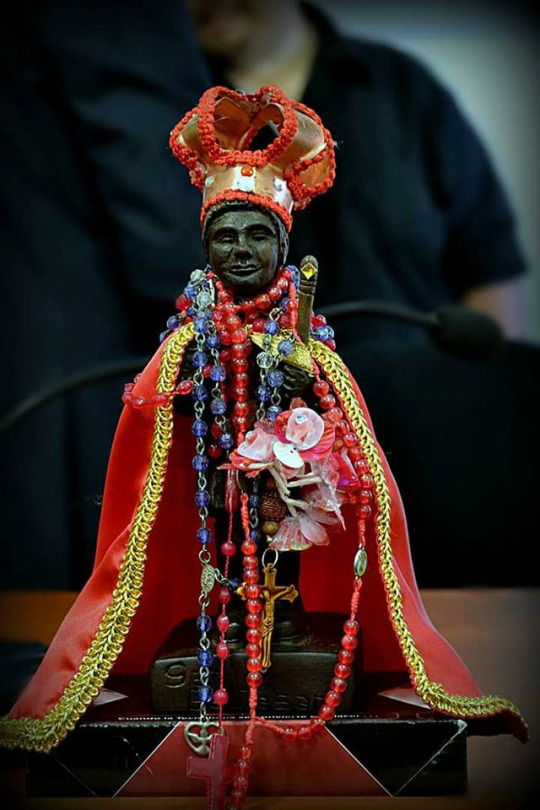
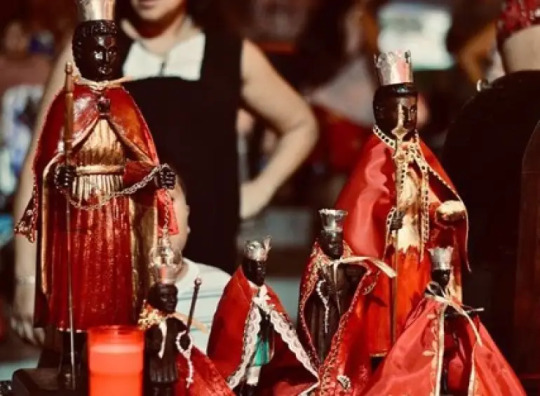
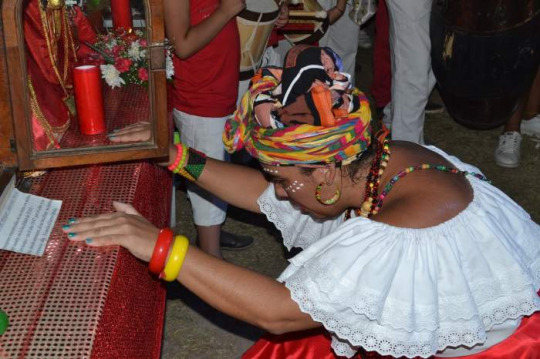


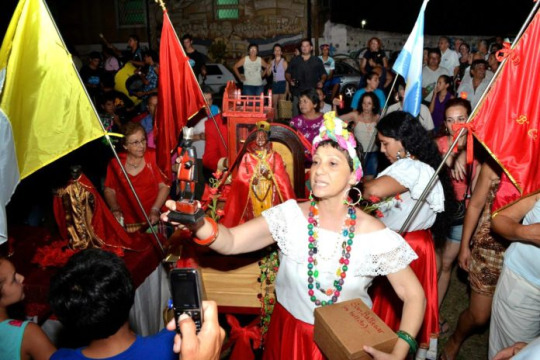
If you compare him to Xangó...
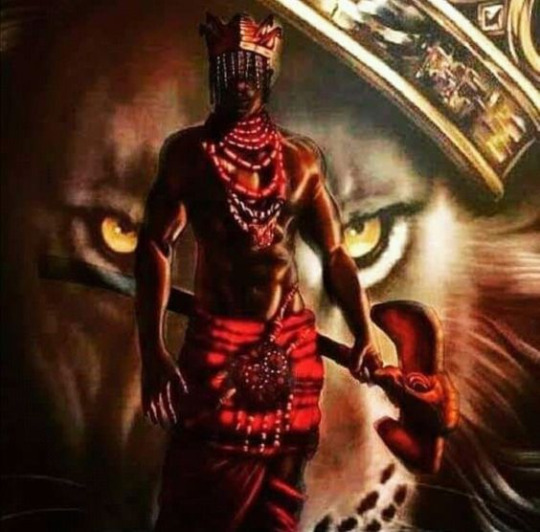
He carries a double-headed axe. He's often depicted wearing a crown. His colors are, surprisingly, also white and red, with gold accents. Also a King and a warrior, also associated with thunderstorms and fire, drums and dance. His followers also wear white and red beaded collares. Ringing any bells...?
Now, I am not saying they are the same Spirit, but there is an undeniable resemblance. You come to your own conclusions. It's kind of obvious that this afrodiasporic cult stems from either (a) a hidden, veiled cult to the orisha(s) or (b) a syncretic cult to african deities (not only orishas but maybe other african spirits too). There is, after all, strong ties not only to Yorubaland but also to Dahomey, Kongo, etc. Just in this instance, the spirit may resemble an orisha but the rhythms and dance are from kongo, so there is much more to it than just one or the other. There is a culture of resistance born from the union of Nations through music, faith and tradition.
Sources:
None of the images here belong to me: San Baltazar and festivities [1,2,3,4-6] and Xangó [1]
Festividad de San Baltasar : performances artístico-religiosas de la cofradía de la ciudad de Corrientes, by Cavalieri, Ana Belén, Universidad Nacional del Nordeste. Facultad de Artes, Diseño y Ciencias de la Cultura, 2018. Available for download at [Link]
San Baltazar, Historias de Corrientes at [Link]
The bamboula Lineage at [Link]
The Orishas, Indiana University at [Link]
#ATRs#afroargentina#afroargentines#afrolatine#afrolatinx#afrolatino#black saint#black saints#st balthazar#st. Balthazar#San Baltazar#Santería#shangó#xangó#santeria#african diaspora#african traditional religions#african diasporic religions#african diaspora religions#ADRs#san baltasar
20 notes
·
View notes
Text
In the thirty years following abolition, the women who once owned enslaved people and their female descendants also wrote about enslavement and loss, but in a remarkably different way. They laid bare their thoughts about the system and how they perceived the roles they had played within it. Interwoven within their tales of privileged living, these women constructed preposterous narratives about slavery that omitted the trauma of separation, loss of self-determination, and violence that emerged in the "Lost Friends" and "Information Wanted" advertisements [posted by formerly enslaved people searching for loved ones]. When former slave owners wrote about slavery, their picture showed no brutality, no privation, no agony, no loss, no tears, no sweat, no blood. They portrayed themselves and their female forebears as forever sacrificing women who had played purely benevolent roles within a nurturing system. Enslaved people had only benefited from their mistresses' sacrifices and acts of benevolence, they wrote, and often expressed their recognition and appreciation of that care through their unwavering loyalty and love. This incongruent "reciprocity" led some writers to openly grieve that their female descendants would "never know the tender tie that existed between mistress and servant."
Former slave-owning women's deeper and more complex investments in slavery help explain why, in the years following the Civil War, they helped construct the South's system of racial segregation, a system premised, as was slavery, upon white supremacy and black oppression. Understanding the direct economic investments white women made in slavery and their stake in its perpetuation, and recognizing the ways they benefited from their whiteness, helps us understand why they and many of their female descendants elected to uphold a white-supremacist order after slavery ended. If we acknowledge that white women stood to personally and directly benefit from the commodification and enslavement of African Americans we can better understand their participation in postwar white-supremacist movements and atrocities such as lynching--as well as their membership in organizations like the Ku Klux Klan. Southern white women's roles in upholding and sustaining slavery form part of the much larger history of white supremacy and oppression. And through it all, they were not passive bystanders. They were co-conspirators.
They Were Her Property: White Women as Slave Owners in the American South by Stephanie E. Jones-Rogers (New Haven: Yale University Press, 2019).
4 notes
·
View notes
Text
Ga. islanders vow to keep fighting change favoring rich buyers

DARIEN, Ga. - Descendants of enslaved people living on a Georgia island vowed to keep fighting after county commissioners voted to double the maximum size of homes allowed in their tiny enclave.
Residents fear the move will accelerate the decline of one of the South’s few surviving Gullah-Geechee communities.
An aspect of the ordinance that residents take issue with is the fact that it erases a clause about protecting the island’s indigenous history.
During public meetings leading up to the vote, the zoning board proposed changes to the ordinance of lowering the newly allowed home size and removing talk of golf courses being added to the island.
Black residents of the Hogg Hummock community on Sapelo Island and their supporters packed a meeting of McIntosh County’s elected commissioners to oppose zoning changes that residents say favor wealthy buyers and will lead to tax increases that could pressure them to sell their land.
ISLAND’S HERITAGE
Gullah-Geechee communities like Hogg Hummock are scattered along the Southeast coast from North Carolina to Florida, where they have endured since their enslaved ancestors were freed by the Civil War. Scholars say these people long separated from the mainland retained much of their African heritage, from their unique dialect to skills and crafts such as cast-net fishing and weaving baskets.
Regardless, commissioners voted 3-2 to weaken zoning restrictions the county adopted nearly three decades ago with the stated intent to help Hogg Hummock’s 30 to 50 residents hold on to their land.
Yolanda Grovner, 54, of Atlanta said she has long planned to retire on land her father, an island native, owns in Hogg Hummock. She left the county courthouse Tuesday night wondering if that will ever happen.
“It’s going to be very, very difficult,” Grovner said. She added: “I think this is their way of pushing residents off the island.”
Hogg Hummock is one of just a few surviving communities in the South of people known as Gullah, or Geechee, in Georgia, whose ancestors worked island slave plantations.
MORE | Mom in Grovetown calls cops on U.S. energy secretary’s staff
Fights with the local government are nothing new to residents and landowners. Dozens successfully appealed staggering property tax hikes in 2012, and residents spent years fighting the county in federal court for basic services such as firefighting equipment and trash collection before county officials settled last year.
“We’re still fighting all the time,” said Maurice Bailey, a Hogg Hummock native whose mother, Cornelia Bailey, was a celebrated storyteller and one of Sapelo Island’s most prominent voices before her death in 2017. “They’re not going to stop. The people moving in don’t respect us as people. They love our food, they love our culture. But they don’t love us.”
Merden Hall, who asked not to be on camera, has lived on Sapelo his whole life. He says he’s worried about the sizes of homes now allowed on the island.
“I’m not comfortable with this. They approved the 3,000 square feet, that’s the only thing I disapprove of, because that’s going to raise property taxes,” he said.
Hogg Hummock’s population has been shrinking in recent decades, and some families have sold their land to outsiders who built vacation homes. New construction has caused tension over how large those homes can be.
Commissioners on Tuesday raised the maximum size of a home in Hogg Hummock to 3,000 square feet of total enclosed space. The previous limit was 1,400 square feet of heated and air-conditioned space.
Commissioner Davis Poole, who supported loosening the size restriction, said it would allow “a modest home enabling a whole family to stay under one roof.”
“The commissioners are not out to destroy the Gullah-Geechee culture or erase the history of Sapelo,” Poole said. “We’re not out to make more money for the county.”
Commission Chairman David Stevens, who said he’s been visiting Sapelo Island since the 1980s, blamed Hogg Hummock’s changing landscape on native owners who sold their land.
“I don’t need anybody to lecture me on the culture of Sapelo Island,” Stevens said, adding: “If you don’t want these outsiders, if you don’t want these new homes being built ... don’t sell your land.”
County officials have argued that size restrictions based on heated and cooled spaced proved impossible to enforce. County attorney Adam Poppell said more than a dozen homes in Hogg Hummock appeared to violate the limits, and in some cases homeowners refused to open their doors to inspectors.
Hogg Hummock landowner Richard Banks equated that to the county letting lawbreakers make the rules.
“If everybody wants to exceed the speed limit, should we increase the speed limits for all the speeders?” Banks said.
Hogg Hummock residents said they were blindsided when the county unveiled its proposed zoning changes on Aug. 16. Commissioners in July had approved sweeping zoning changes throughout McIntosh County, but had left Hogg Hummock alone.
Commissioner Roger Lotson, the only Black member of the county commission, voted against the changes and warned his colleagues that he fears they will end up back in court for rushing them.
Two attorneys from the Southern Poverty Law Center sat in the front row. Attorney Anjana Joshi said they had “due process and equal protection concerns” about the way the zoning ordinance was amended.
“In our view, this was not done correctly,” said Joshi, who added: “We’re just getting started.”
Located about 60 miles south of Savannah, Sapelo Island remains separated from the mainland and reachable only by boat. Since 1976, the state of Georgia has owned most of its 30 square miles of largely unspoiled wilderness. Hogg Hummock, also known as Hog Hammock, sits on less than a square mile.
Hogg Hummock earned a place in 1996 on the National Register of Historic Places, the official list of the United States’ treasured historic sites. But for protections to preserve the community, residents depend on the local government in McIntosh County, where 65% of the 11,100 residents are white.
#Ga. islanders vow to keep fighting change favoring rich buyers#Gullah Geechee#Gullah Land#sapelo#sapelo island#Freedmen Lands#Stolen Lands#nrohp#national register of historic places
55 notes
·
View notes
Text
To the editor: As African Americans, we are not surprised that a significant majority of non-Black Californians oppose the idea of the state offering cash payments to the descendants of enslaved Black people.
Public opinion does not form in a vacuum. For decades the media have besmirched the image of African Americans, often depicting us as violent criminals, welfare queens and parasites. In contrast, the requests of other groups who were not subject to widespread media vilification have been more favorably received.
For example, large numbers of Americans endorsed cash payments to Japanese citizens who were incarcerated in prison camps during World War II. The same can be said of financial redress granted to Native Americans.
Let us be clear: 246 years of free labor from millions of Black people anchored this nation’s early development and ultimately catapulted America into becoming a modern superpower. In a capitalist system, cash is the best way to provide restitution to the formerly enslaved, and the media should report this fact to set the record straight on America’s unique indebtedness to Black people.
Patricia A. Moore, Compton
The writer is national chair for reparations at the National Assn. for Equal Justice in America.
..
To the editor: The headline surely led most readers to believe that cash payments to descendants of enslaved people are the primary focus of the recommendations proposed by the California Reparations Task Force.
In mentioning other recommendations, the article chose those that would likely be hot-button issues for those who oppose reparations.
Focusing on ending the death penalty, paying fair market value for jail and prison labor, and restoring voting rights to all formerly and currently incarcerated people treats as secondary the long-ranging recommendations that are intended to address the after-effects of slavery and racial discrimination. The massive disparities have affected Black people in every walk of life.
Touching on recommendations that will have an impact on eliminating these disparities would have given readers a more balanced view of what the task force is attempting to accomplish.
Denise Flanagan, Riverside
..
To the editor: Slavery was abolished in the U.S. in 1865. If a single generation is 25 years, more than six have passed since then.
The Great Famine in Ireland, which killed about 1 million people, took place during roughly the same period (1840s-50s). The famine was a direct cause of the overlording British taking Ireland’s crops for their own consumption.
With generations having passed since then, it has never occurred to me to seek reparations from the British due to their mistreatment of my ancestors.
If Gov. Gavin Newsom has aspirations for a continued political career, he had better dump this idea immediately. Not only is paying cash reparations a bad idea, the right-wing media will make sure it sticks to him like Hillary Clinton’s emails did to her.
Dan O’Connell, Santa Clarita
..
To the editor: It’s not surprising to see resistance to cash reparations because the ground has not been prepared for our nation to accept responsibility for the consequences of chattel slavery.
To understand why, look only to the unwillingness to educate our young about the oppression of Black people because some feel non-Black children might feel bad.
This ought to be the fundamental message: Our tradition of justice requires that people suffering damages be made whole.
I suggest three areas for remediation: enhancements in the health, wealth and educational opportunities of traditional Black communities. These might take the form of greatly improved free schools and medical facilities, preferential small business and mortgage programs, and the means to pass on generational wealth.
Some may suggest other forms of remediation. But first, a persistent campaign must persuade the majority that justice is long overdue.
Philip Baer, North Hollywood
https://x.com/KamilahVMoore/status/1702743762785693851?s=20
#Reparations#AB3121#https://x.com/KamilahVMoore/status/1702743762785693851?s=20#Kamilah Moore#California#Reparations for Black Freedmen
7 notes
·
View notes
Photo


youtube
Glenn Loury: The Case for Black Patriotism
Frederick Douglass, the escaped slave and great abolitionist, in a famous speech of 1852 titled “What to the Slave Is the Fourth of July?,” asked America whether he had a share in the nation’s civic inheritance. Douglass was cautiously hopeful that America might be faithful to its founding principles and grant liberty and equality to his people. But he had to plead with his audience to consider the gravity of the times; he had to indict his country for not standing up to its own ideals.
Today we stand 170 years later. Douglass’s criticism of America remains fashionable, but many Americans seem to have forgotten what it was about America that Douglass wanted to be a part of. When we talk about race and America, we must ask whether the standoffishness exemplified, by, for example, the “America ain’t so great, and never was” posture popular on campuses and in newsrooms, truly serves the interests of black Americans. The narrative we blacks settle upon about the American project is fundamentally important. Is this, basically, a good country that affords boundless opportunity to all who are fortunate enough to enjoy the privileges and bear the responsibilities of American citizenship? Or, is this, basically, a venal, immoral, rapacious bandit-society of plundering white supremacists founded in genocide and slavery, and propelled by capitalist greed and unrepentant racism?
I wish to make the case for unabashed black patriotism—for the forthright embrace of America by black people. Our birthright citizenship in this great republic is an inheritance of immense value. Our Americanness is much more important than our blackness.
Of course, there is some warrant in the historical record for both sentiments. African slavery flourished at the time of the founding, true enough. And yet, within a century of the founding slavery was gone and people who had been chattel became citizens of the United States. Should equality before the law have taken another hundred years? Should my ancestors have been enslaved in the first place? No and no. But we must not forget that slavery had been commonplace since antiquity. Emancipation, the freeing of slaves en masse as the result of a movement for abolition—that was a new idea. It was a Western idea, brought to fruition in our own United States of America. It would not have been possible without the philosophical insights and moral commitments cultivated in the West during the Enlightenment—ideas about the essential dignity of human persons.
The founding of the United States of America was a world-historic event by means of which enlightenment ideals about the rights of individual persons and the legitimacy of state power got instantiated for the first time in real institutions. The United States of America fought authoritarian fascism and communism in the Pacific and Europe in the mid-twentieth century. Our democracy, flawed as it most surely is, has been a beacon to billions of people. On our shores, we have witnessed since the end of the Civil War the greatest transformation in the status of an enserfed people that is to be found anywhere in world history. Some 46 million strong, we black Americans have become by far the richest and most powerful large population of African descent on this planet, and it’s not even close. We have access to more than five times the income of the typical Nigerian, the richest nation in all of sub-Saharan Africa.
I am a descendant of slaves and I came up in the 1950s and 1960s on Chicago’s South Side; I didn’t have an easy upbringing, but I was a beneficiary of the civil rights revolution, which made possible for me a life that my forebears only dreamed of. I became an economist and Ivy League college professor. I am a product of the Enlightenment, and I am an inheritor of its great traditions: Tolstoy is mine. Dickens is mine. Newton and Maxwell and Einstein are mine.
We Americans, of all stripes, have a great deal in common, and our commonalities can be used to build bridges, undergirded by patriotism, between black America and the nation as a whole. We all want the same things. We want a shot at the American Dream. We want each generation to do better than the ones that came before it. Connections among groups in America could be stronger if we focused more on the things we have in common than on the things that divide us.
Those who make their living by focusing on our differences believe that there is something fundamentally wrong with the American project. They’re wrong.
They betray the legacy of Frederick Douglass, and we should resist their divisive rhetoric. It is easy to overstate the racial problems facing our country, and to understate what we have achieved.
Join me in valuing the American tradition at FairForAll.org
#Foundation Against Intolerance and Racism#FAIR for All#Glenn Loury#Frederick Douglass#abolition#patriotism#equality before the law#Enlightenment#Enlightenment values#common humanity#liberal values#liberalism#Emancipation#Civil Rights Movement#American dream#inverted exceptionalism#slavery#religion is a mental illness
18 notes
·
View notes
Photo
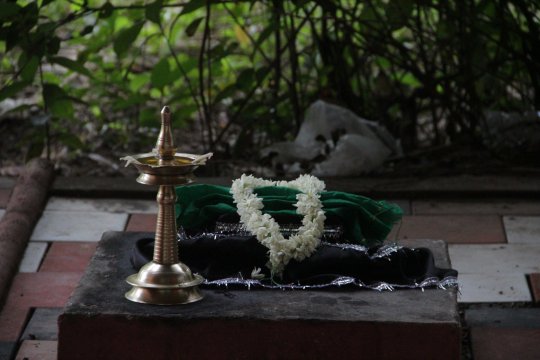

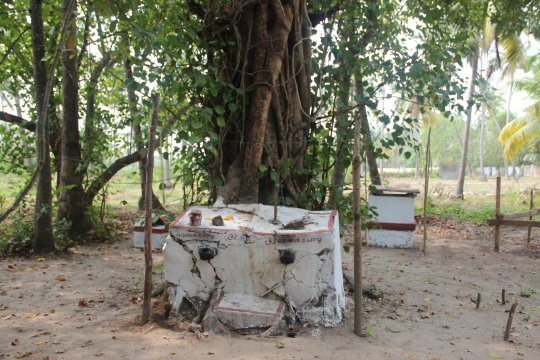
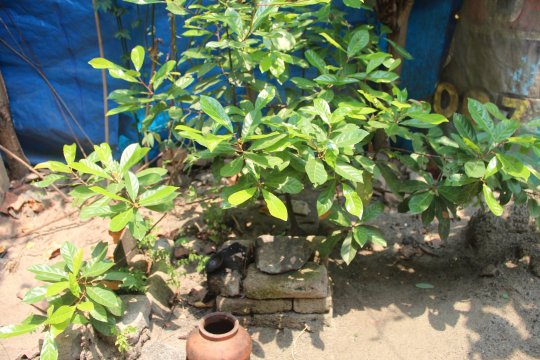
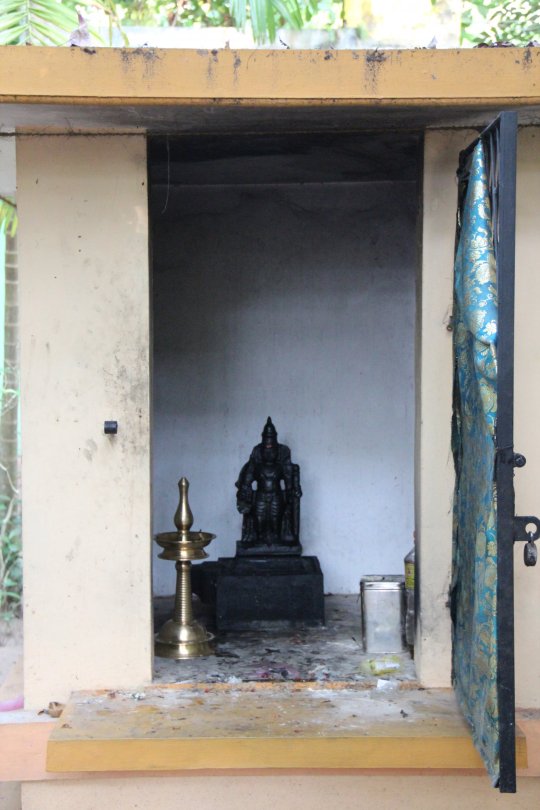
We know about the enslavement of blacks to the Americas, what many do not know is that they were taken by the Portuguese to India, their descendants still exist there, plus some who were unlucky and died in slavery developed a popular devotion that out of region where they are honored are unknown.
This is the story of the Kappiri Muthappan (black great-grandfather), and their cult along the coastal regions of Thrissur and Kochi in the state of Kerala. Shrines to African spirits known locally as Kappiri (black person) or in some cases as Kappiri Muthappan (black great-grandfather) are instrumental in restoring the memories of Africans in the regional state of Kerala. In the vernacular language of Malayalam, Kappiri means "black person", which is a dialectical variant of the word Kaffir, derived from the Arabic word Qafr denoting "non-Muslim" person which has been extended to mean "Africans" more generally. Although the memories of Africans in Kerala are fractured, distorted and situational in many cases, shrines dedicated to Kappiri keep African memories alive, even as the non-Africans who maintain and visit the shrines hope that their lives will be improved by the spirit's interventions. .
Portuguese merchants began to rule Kerala, the center of the spice trade, with an iron fist in the early 1500s. When the Dutch attacked and took control in 1663, the wealthy colonialists, in an effort to preserve their illicit loot, created a way to hide your dreadful treasures. They built niches in a cement wall, placed the gold in the arms of their African slaves, then plastered the wall closed, with the slaves still alive inside. The idea was that when the merchants returned, the ghosts of their faithful slaves would lead them back to the treasury. So says the tradition.
Historian KL Bernard's book 'History of Fort Cochin' is one of the few that has attempted to address this aspect of Kochi's history. Centuries later, a mythical figure, Kapiri Muttapan, became the embodiment of these martyred slaves.
People of all religions pay homage and ask the spirit for favors or guidance. They light candles and leave offerings, usually cigars or toddy (alcoholic drink), at small shrines in the city on Tuesdays and Fridays. The book reports that the skeletons were found in two wall niches - kappiri mathils - on Rose Street near Fort Kochi nearly 450 years after enslaved men died.
In these sanctuaries, sometimes simple platforms usually only with a black granite stone, they are honored along with other ancestral spirits in the region.
37 notes
·
View notes
Text
California Reparations
The conversation on the centuries overdue debt of US lineage-based reparations owed to Black Americans is still going strong from state bills and conferences to articles and panels. Federal reparations is the top goal, but the state ones are being sought as well. The unfinished business of Special Field Order No. 15 plus interest. “Wouldn’t that cause the US to go bankrupt?” Nope.
I was gonna wait until the final Cali report is released on July 1, 2023. (If you haven’t read the full 400+ page interim report, it’s here. I’ll plug the audio version when it’s finished.) But since there’s a definite number for one aspect, here ya go:
The California Reparations Task Force for AB 3121 — who are leading in the first, pure reparative bill to redress the state-sanctioned terror, genocide, discriminatory laws (Black Codes/Code Noir, Jim Crow), stolen wealth and land theft — are recommending each person to receive $223,200 for housing discrimination ($559 billion - the nation's biggest restitution effort ever…so far). This is only for Cali.
Shit like this is just...
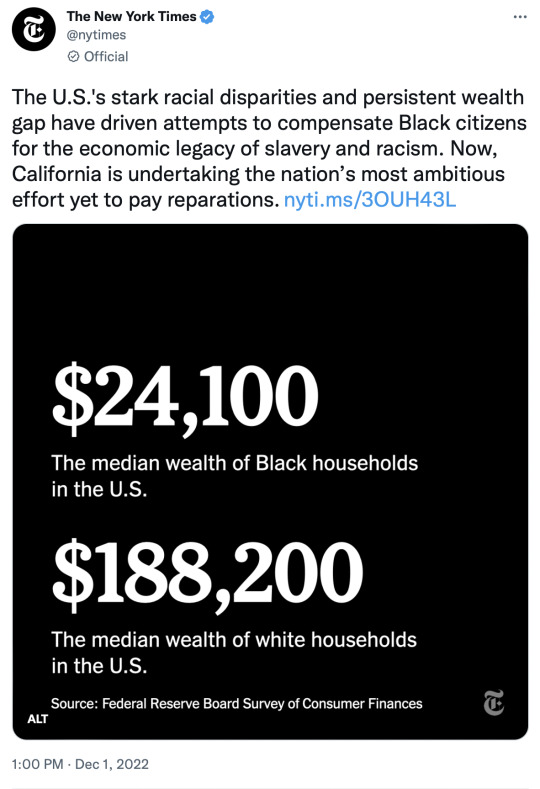
Reaping the benefits in your house and the bricks your ancestors laid...
When you get into the liquid assets...
There’ll be protective policies in place and more because after all...
There’s 5 steps to reparations under international law:
Cessation/Assurance of Non-Repetition - like structural and institutional policies
Restitution - like the account for stolen land, property and labor (real or intellectual)
Compensation - like cash
Satisfaction - like a formal apology
Rehabilitation - like free medical care, free education, free legal and trauma services
Kamailah Moore, Esq., who is the Chairwoman of the AB 3121 California Task Force, breaks it down in this 1 minute 37 second clip from a Revolt Summit panel on held Sept 2022.
Whether you live in Cali or not, if you’re the descendant of free people or enslaved people who were subjected to US chattel enslavement of building this country from scratch and (re)classified under the US caste system as Black or Mulatto, later reclassified as Negro to Colored to Black again to Afro American to African American to Black/African American to “Black or African American” currently, do your genealogy. Prepare. This is not that damn spit test. Get your documents together.
There are a lot genealogical websites. I use Ancestry.com and FamilySearch.org. The latter is thorough than a mf and great for cross verifying what pops up or you trace on Ancestry.com. Also, the Card Catalog option on Ancestry is key. Both headquarters are in Utah. You can physically go to the FamilySearch Center, if you choose.
Many of us have family members who don’t fuck with the US census or haven’t done it in decades, so the birth certificate and death certificate paper trail will be the route to go leading back to the census record docs. Dig into the National Archive Catalog. Touch those microfilms if you can. We are well documented. The United States governmental corporation is obsessed with us. They keep them receipts like a serial killer keeps mementos. It’s there. The farther back you go, be patient and take breaks. Also, check that old bible. Make note of everyone from safe kept obituaries. Talk to your fam, especially the elders.
SN: I have more research to do, but one day I’m want to break down the Negro and Mulatto part of caste system because that shit is nothing but a bag of trickery and confusion the farther you go back in records. The complexity of paper genocide in classification that you wouldn’t be privy to unless you crack that 1870 wall and keep going back. (I haven’t just traced mine; I’ve been assisting others.)
Certain words don’t have the same meaning as what we would consider them today. Mulatto, for one, meant more than someone who was half and half. The answers sit in plain sight within centuries back state laws. When I get around to writing it, I’m starting from the most recent one with ol’ Jesse “Cherokee Indian card” Jackson head ass loudly calling for a reclassified people to be yet again reclassified by a misnomer — African American — that we didn’t ask for and looks like an immigrant status. The problem is more than obvious today. Everyone who has differing homelands being classified under the same label as if we’re a monolith...one big nigga 🙃. This is being straightened out.
25 notes
·
View notes
Text
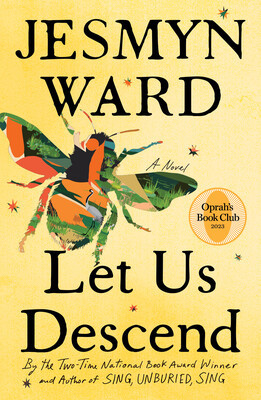

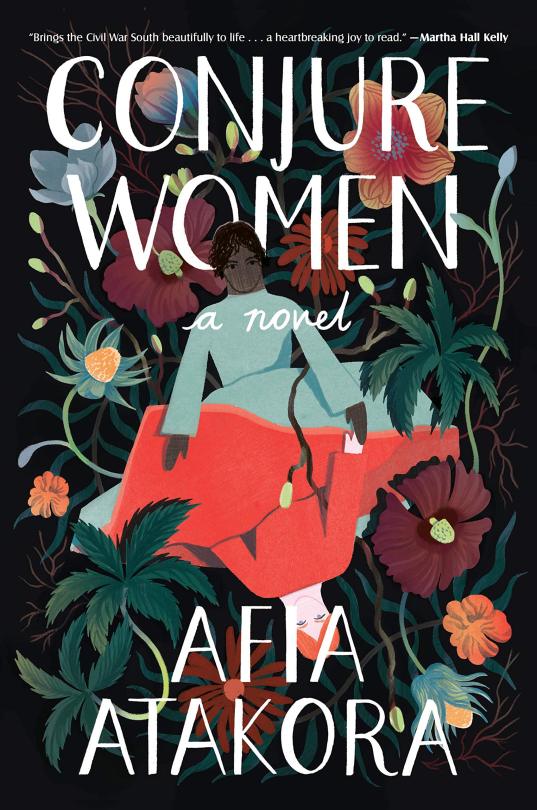

Read-Alike Friday: Jesmyn Ward
Let Us Descend by Jesmyn Ward
Let Us Descend is a reimagining of American slavery, as beautifully rendered as it is heart-wrenching. Searching, harrowing, replete with transcendent love, the novel is a journey from the rice fields of the Carolinas to the slave markets of New Orleans and into the fearsome heart of a Louisiana sugar plantation.
Annis, sold south by the white enslaver who fathered her, is the reader’s guide through this hellscape. As she struggles through the miles-long march, Annis turns inward, seeking comfort from memories of her mother and stories of her African warrior grandmother. Throughout, she opens herself to a world beyond this world, one teeming with spirits: of earth and water, of myth and history; spirits who nurture and give, and those who manipulate and take. While Ward leads readers through the descent, this, her fourth novel, is ultimately a story of rebirth and reclamation.
Yonder by Jabari Asim
They call themselves the Stolen. Their owners call them captives. They are taught their captors’ tongues and their beliefs but they have a language and rituals all their own.
In a world that would be allegorical if it weren’t saturated in harsh truths, Cato and William meet at Placid Hall, a plantation in an unspecified part of the American South. Subject to the whims of their tyrannical and eccentric captor, Cannonball Greene, they never know what harm may befall them: inhumane physical toil in the plantation’s quarry by day, a beating by night, or the sale of a loved one at any moment. It’s that cruel practice—the wanton destruction of love, the belief that Black people aren’t even capable of loving—that hurts the most.
It hurts the reserved and stubborn William, who finds himself falling for Margaret, a small but mighty woman with self-possession beyond her years. And it hurts Cato, whose first love, Iris, was sold off with no forewarning. He now finds solace in his hearty band of friends, including William, who is like a brother; Margaret; Little Zander; and Milton, a gifted artist. There is also Pandora, with thick braids and long limbs, whose beauty calls to him.
Their relationships begin to fray when a visiting minister with a mysterious past starts to fill their heads with ideas about independence. He tells them that with freedom comes the right to choose the small things—when to dine, when to begin and end work—as well as the big things, such as whom and how to love. Do they follow the preacher and pursue the unknown? Confined in a landscape marked by deceit and uncertainty, who can they trust?
Conjure Women by Afia Atakora
Conjure Women is a sweeping story that brings the world of the South before and after the Civil War vividly to life. Spanning eras and generations, it tells of the lives of three unforgettable women: Miss May Belle, a wise healing woman; her precocious and observant daughter Rue, who is reluctant to follow in her mother's footsteps as a midwife; and their master's daughter Varina. The secrets and bonds among these women and their community come to a head at the beginning of a war and at the birth of an accursed child, who sets the townspeople alight with fear and a spreading superstition that threatens their newly won, tenuous freedom.
Magnificently written, brilliantly researched, richly imagined, Conjure Women moves back and forth in time to tell the haunting story of Rue, Varina, and May Belle, their passions and friendships, and the lengths they will go to save themselves and those they love.
The Water Dancer by Ta-Nehisi Coates
Young Hiram Walker was born into bondage. When his mother was sold away, Hiram was robbed of all memory of her—but was gifted with a mysterious power. Years later, when Hiram almost drowns in a river, that same power saves his life. This brush with death births an urgency in Hiram and a daring scheme: to escape from the only home he’s ever known.
So begins an unexpected journey that takes Hiram from the corrupt grandeur of Virginia’s proud plantations to desperate guerrilla cells in the wilderness, from the coffin of the Deep South to dangerously idealistic movements in the North. Even as he’s enlisted in the underground war between slavers and the enslaved, Hiram’s resolve to rescue the family he left behind endures.
This is the dramatic story of an atrocity inflicted on generations of women, men, and children—the violent and capricious separation of families—and the war they waged to simply make lives with the people they loved.
#historical fiction#magical realism#jesmyn ward#reading recommendations#reading recs#book recommendations#book recs#library books#tbr#tbr pile#to read#booklr#book tumblr#book blog#library blog#readers advisory
2 notes
·
View notes